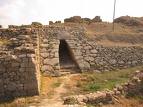 Ugarit (modern site Ras Shamra رأس شمرة ; meaning "top/head/cape of the wild fennel" in Arabic) was an ancient cosmopolitan port city, sited on the Mediterranean coast of northern Syria a few kilometers north of the modern city of Latakia. Ugarit sent tribute to Egypt and maintained trade and diplomatic connections with Cyprus (called Alashiya), documented in the archives recovered from the site and corroborated by Mycenaean and Cypriot pottery found there. The polity was at its height from ca. 1450 BC until 1200 BC.
Ugarit (modern site Ras Shamra رأس شمرة ; meaning "top/head/cape of the wild fennel" in Arabic) was an ancient cosmopolitan port city, sited on the Mediterranean coast of northern Syria a few kilometers north of the modern city of Latakia. Ugarit sent tribute to Egypt and maintained trade and diplomatic connections with Cyprus (called Alashiya), documented in the archives recovered from the site and corroborated by Mycenaean and Cypriot pottery found there. The polity was at its height from ca. 1450 BC until 1200 BC.
Ugarit's location was forgotten until 1928 when an Alawite peasant accidentally opened an old tomb while plowing a field. The discovered area was the Necropolis of Ugarit. Excavations have since revealed an important city that takes its place alongside Ur and Eridu as a cradle of urban culture, with a prehistory reaching back to c. 6000 BC, perhaps because it was both a port and at the entrance of the inland trade route to the Euphrates and Tigris lands.
Most excavations of Ugarit were undertaken by archaeologist Claude Schaeffer from the Prehistoric and Gallo-Roman Museum of Strasbourg.
The excavations uncovered a royal palace of 90 rooms laid out around eight enclosed courtyards, many ambitious private dwellings, including two private libraries (one belonging to a diplomat named Rapanu) that contained diplomatic, legal, economic, administrative, scholastic, literary and religious texts. Crowning the hill where the city was built were two main temples: one to Baal the "king", son of El, and one to Dagon, the chthonic god of fertility and wheat.
 On excavation of the site, several deposits of cuneiform clay tablets were found, constituting a palace library, a temple library and -- apparently unique in the world at the time -- two private libraries; all dating from the last phase of Ugarit, around 1200 BC. The tablets found at this cosmopolitan center are written in four languages: Sumerian, Hurrian, Akkadian (the language of diplomacy in the ancient Near East), and Ugaritic (of which nothing had been known before). No less than seven different scripts were in use at Ugarit: Egyptian and Luwian hieroglyphics, and Cypro-Minoan, Sumerian, Akkadian, Hurrian, and Ugaritic cuneiform.
On excavation of the site, several deposits of cuneiform clay tablets were found, constituting a palace library, a temple library and -- apparently unique in the world at the time -- two private libraries; all dating from the last phase of Ugarit, around 1200 BC. The tablets found at this cosmopolitan center are written in four languages: Sumerian, Hurrian, Akkadian (the language of diplomacy in the ancient Near East), and Ugaritic (of which nothing had been known before). No less than seven different scripts were in use at Ugarit: Egyptian and Luwian hieroglyphics, and Cypro-Minoan, Sumerian, Akkadian, Hurrian, and Ugaritic cuneiform.
During excavations in 1958, yet another library of tablets was uncovered. These were, however, sold on the black market and not immediately recovered. The "Claremont Ras Shamra Tablets" are now housed at the Institute for Antiquity and Christianity, Claremont School of Theology, Claremont, California. They were edited by Loren R. Fisher in 1971. In 1973, an archive containing around 120 tablets was discovered during rescue excavations; in 1994 more than 300 further tablets were discovered on this site in a large ashlar building, covering the final years of the Bronze Age city's existence.
The most important piece of literature recovered from Ugarit is arguably the Baal cycle, describing the basis for the religion and cult of the Canaanite Baal.
 Scribes in Ugarit appear to have originated the Ugaritic alphabet around 1400 BC; 30 letters, corresponding to sounds, were adapted from cuneiform characters and inscribed on clay tablets (but cf. Byblos). A debate exists as to whether the Phoenician or Ugaritic alphabet was first. While many of the letters show little or no formal similarity, the standard letter order (preserved in the latin alphabet as A, B, C, D, etc.) shows strong similarities between the two, suggesting that the Phoenician and Ugaritic systems were not wholly independent inventions.
Scribes in Ugarit appear to have originated the Ugaritic alphabet around 1400 BC; 30 letters, corresponding to sounds, were adapted from cuneiform characters and inscribed on clay tablets (but cf. Byblos). A debate exists as to whether the Phoenician or Ugaritic alphabet was first. While many of the letters show little or no formal similarity, the standard letter order (preserved in the latin alphabet as A, B, C, D, etc.) shows strong similarities between the two, suggesting that the Phoenician and Ugaritic systems were not wholly independent inventions.
It was later the Phoenician alphabet that spread through the Aegean and on Phoenician trade routes throughout the Mediterranean. The Phoenician system became the basis for the first true alphabet, when it was adopted by Greek speakers who modified some of its signs to represent vowel sounds as well, and as such was in turn adopted and modified by populations in Italy, including ancestors of the Romans). Compared with the difficulty of writing Akkadian in cuneiform—such as the Amarna Letters, from ca. 1350 BC— the flexibility of an alphabet opened a horizon of literacy to many more kinds of people. In contrast, the syllabary (called Linear B) used in Mycenaean Greek palace sites at about the same time was so cumbersome that literacy was limited largely to administrative specialists.


